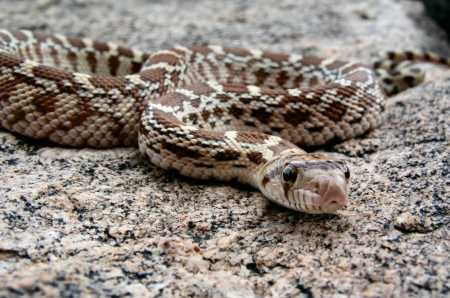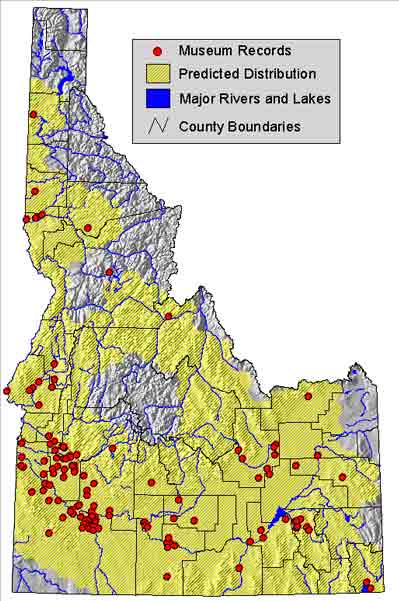Pituophis catenifer, Goper Snake
 Courtesy of Young Cage
Courtesy of Young Cage
Taxonomy
Kingdom- Animalia
Phylum- Chordata
Class- Reptilia
Order- Squamata
Family- Colubridae
Genus- Pituophis
Species- catenifer
Identification
The gopher snake is Idaho's largest snake, with adults total length ranging from 75- 275 cm. This large snakes dorsal side is a beige to white color with dark contrasting saddles and blotches that cover the length of the snake. The ventral side is also of light color and may have a darker checker pattern. (Cossel J. 1998) A black eye stripe is located on the snakes head, between the eyes and continuing vertically below the eyes. (Sonoran Desert Reptiles...[updated 2003]) Scales of the gopher snake are keeled, which helps identify juveniles of this species from similar appearing juveniles, such as the racer. Adults may be misidentified as rattlesnakes due to similar coloration, body pattern and defensive behavior. However, unlike the rattlesnake, gopher snakes are non-venomous, have round pupils and a tapered tail without the rattle tip.(Cossel J. 1998)
Distribution
Nationally the gopher snake is found in suitable habitat from southern Canada to northern Mexico. Within Idaho this snake occurs throughout the state with the exception of the panhandle and most of the eastern border of the state. (Cossel J. 1998)
 (Cossel J. 1998)
(Cossel J. 1998)
Habitat
Gopher snakes occur throughout most of Idaho and the west in a vast array of habitat ranges. Types of preferred habitat include dry deserts, coniferous forests, agricultural lands, costal dunes and open pastures. (Fagan, D. 2008)
Behavior
Throughout their range gopher snakes search for food in burrows, rocky areas and trees. Prey items consist of rodents, rabbits, birds and bird eggs, insects and lizards. Constriction and suffocation are used to kill prey. Although most gopher snakes are diurnal, some change their behavior to adapt to the hot summer days in the desert. In contrast, when in need of warmth, the gopher snake can be found sunning on rocks and/ or payment. (Fagan, D. 2008)
When threatened, the gopher snake will coil up, flatten its head and shake its tail, which when located in dried leaves can sound much like a rattlesnake.(Sonoran Desert Reptiles....[ updated 2003]) This method of mimicking can be beneficial to deter predators, however this behavior can also lead to misidentification by humans and therefore death. (Fagan, D. 2008.)
Reproduction
Breeding season begins in April and continues through May with females producing one to two clutches of young. Each clutch may contain 2-24 eggs which are laid six weeks after mating. Within 10 weeks the fully developed young snakes break from their eggshells and begin their life. After three to four years gopher snakes reach maturity. (Fagan, D. 2008.)
Scientific Study
In 1997, Javier Rodriguez-Robles conducted a study in central California to gather data on the home range size and use by gopher snakes. By knowing the home ranges of gopher snakes, further studies may be done to better understand seasonal behaviors, as well as behaviors between individuals. For this study, Rodriguez-Robles collected four male gopher snakes and implanted a radio transmitter into each of the snakes. Once released to their original capture site, home range locations were recorded one to four times a week for each male from May 1997 to July 1998. With the collected data and use of a fixed kernel density estimator, Rodriguez-Robles found 95% of home range sizes varying between 0.89-1.78 ha. Also, the areas within the overall home range that are used the most ranged from 0.1-0.29 ha. Although three of the four snakes home ranges were located close to each other, they never overlapped. This suggests that gopher snakes use limited home ranges at least for part of their active season. (Rodriguez-Robles 2003)
References
Cage, Young. 2006. Tucson Herpetology Society. Gopher snake photograph.
Cossel J. 1998. Digital Atlas of Idaho, Pituophis catenifer.[Internet]. [cited 2008 September 27]. Available from: http://imnh.isu.edu/digitalatlas/bio/reptile/main/repfram.htm
Fagan, D. 2008. Gopher Snakes.Desert USA, The Ultimate Desert Resource. [Internet]. [cited 2008 September 30];10:30. Available from: http://www.desertusa.com/mag99/july/papr/gophersnake.html
Rodriguez-Robles, J.A. 2003. Home Range of Gopher Snakes (Pituophis catenifer, Colubridae) in Central California. Copia. 2003 (2):391-396
Sonoran Desert Reptiles Pituophis catenifer (Goper snake) [Internet]. [updated 2003]Cabeza Prieta Natural History Association; [cited 2008 September 29]. Available from: http://www.cabezaprieta.org/reptile_page.php?id=1320
Created by~ Lori Eichel
Comments (0)
You don't have permission to comment on this page.